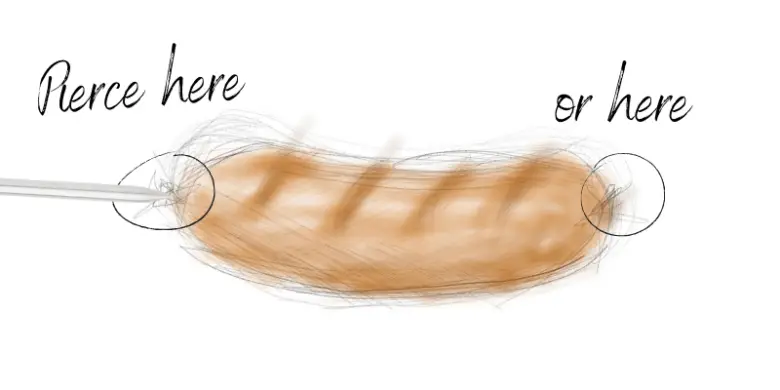Beef and Pork Sausage Internal Temp
Sausages are delicious, but they're also tricky to cook. Here's how to tell if they're done—with or without a meat thermometer.
Advertisements
Hearty, piquant, and tasty, sausages are a bona fide favorite among carnivores. And for good reason: every decent store carries at least a few varieties of sausages—and a single pack can feed the whole family inexpensively.
But buying sausages is the easy part. Cooking them, less so.
Once you've unwrapped the sausages from the grocery bags and you've slapped them on the hot skillet, how do you know when they're done? (And what's the deal with the degree to which meat is cooked, anyway?)
Raw or undercooked sausages can contain pathogenic bacteria that can make you sick, the USDA's Food Safety and Inspection Service says. To become safe to eat, sausages must be cooked to a minimum internal temperature specific to each type of meat.
According to the Centers for Disease Control and Prevention, 48 million Americans get sick from food-borne illnesses every year. Of them, 128,000 are hospitalized, and 3,000 die.
Advertisements
Clearly, cooking meat to a safe internal temperature is important.
To tell if sausages are done cooking, use a meat thermometer. Insert the tip of the probe into the end of the link and wait a few seconds to get an accurate reading. Sausage is done when the internal temperature reaches 160°F (70°C) for beef, pork, and lamb; 165°F (74°C) for chicken, duck, goose, and game birds.
With a meat thermometer, you don't have to pierce the casings on the sausages. If you do, the juices in the meat will run out, and the sausages will come out dry and tough. The tip of the meat thermometer should be inserted into the small opening on each side of the sausage where it was twisted into links.

(A good instant-read meat thermometer won't set you back all that much and, with it, you can elevate your cooking to new heights. When in doubt, check out my meat thermometer picks.)
Still, not everyone who's reading this article has a meat thermometer handy—and some don't intend on buying one.
How can you tell if sausages are done without a meat thermometer?
Cook the sausages, turning every minute or two, until they are golden brown on all sides. Then remove one of the sausages from the heat and cut it crosswise towards the end. If it's done, it will be firm, juicy, and taupe-colored. If it's undercooked, it will be soft to the touch, bloody on the inside, and colored pink.
The technique above applies to grilled, oven-roast, and pan-fried sausages. Boiled bratwursts and other boiled sausages are a world of their own.
Where exactly to cut the sausages, you're probably wondering?
The answer depends on what you plan to use them for once they're fully cooked.

Suppose you're briefly browning the sausages, so that you can chop them up and throw them in a stew. Test one of them for doneness by cutting a quarter-sized piece from one of the ends.
Let's imagine that you'll need to cut the sausages into halves anyway, as you plan to put them between hot dog buns to make sausage sandwiches. Check for doneness by—no prizes for guessing—cutting one of them into halves.
Sausage Doneness Temperature
| Sausage Meat | Minimum Internal Temperature | Resting Time |
|---|---|---|
| Beef sausage | 160°F (71.1°C) | 3 minutes |
| Pork sausage | 160°F (71.1°C) | 3 minutes |
| Pork and beef sausage | 160°F (71.1°C) | 3 minutes |
| Chicken sausage | 165°F (73.8°C) | 3 minutes |
| Game sausage | 165°F (73.8°C) | 3 minutes |
| Turkey sausage | 165°F (73.8°C) | 3 minutes |
| Wild fowl sausage | 165°F (73.8°C) | 3 minutes |
Cook all of your sausages to the USDA-prescribed minimum internal temperature as measured by a meat thermometer.
Rest the sausages for 3 minutes after coming off the heat. The meat will continue cooking in its residual heat, tenderizing itself and sealing the juices in.
Advertisements
Why Are My Sausages Undercooked?
When your sausages are blackened and burnt on the surface but cold and raw at the center, this means that you cooked them on overly high heat.
This is a classic problem that many home cooks experience when they prepare meat. Unfortunately, there isn't much that you can do to salvage the burnt sausages other than cutting out the scorched bits and cook whatever is left in a soup, stew, or chili.
The good news is that putting a stop to raw and undercooked sausages is simpler than you probably think.
Cook your sausages—and all of your meats—low and slow. For example, I pan-fry most of my meats over medium heat and roast them in a 350°F (180°C) oven.
Through much trial and error, I've found the heat on those settings to be "just enough" for proper browning and caramelization on the outside of my meats while being "gentle enough" to cook them through on the inside.
Advertisements
Should You Cut Up or Prick Sausages Before Cooking?
When it comes to cutting up or pricking sausages before cooking, there seem to be two schools of thought out there. The jury's out on which is right, and which is wrong.
The advocates for this technique claim that sausages must be cut up or pricked in several spots to let the steam escape, preventing the casings from bursting.
The critics say that it lets not just the moisture—but also the fats and the juices—escape from the meat, and that sausages come out dry and chewy when you cut them up or pierce them before cooking.
My experience is that cooking sausages low and slow, as I suggested above, won't cause their skin to rapture. And I agree that the less you poke, pierce, or cut them before (or during) cooking, the more succulent they come out.
Advertisements
How to Pan-Fry Sausages on the Stove
Frying sausages is quick, requires only a skillet, and works with pretty much any sausage variety. You could even throw in a few white onions, peeled and cut into quarters, to impart some sweetness to the sausages.
- Bring the sausages to room temperature. I usually do this by taking the sausages out of the fridge—and resting them on the counter for a few minutes before breaking the original packaging and frying them up.
- Grease the skillet with cooking oil and preheat it for 2-3 minutes over medium heat. You only need 1-2 tablespoons of oil to grease the bottom and sides of your skillet to prevent the sausages from sticking and keep their casings intact.
- Fry the sausages, turning them occasionally, until they've turned golden brown on all sides. If the sausages start to blacken on the surface or the oil in your pan begins to emit excessive smoke, adjust the knob on your stovetop; that's a sign that you're using too much heat.
- The sausages, depending on their size and the amount of heat you use, normally cook in 10-15 minutes. You know that they're done when you test their internal temperature with a meat thermometer, and it reads at least 160°F (70°C) for sausages containing beef, pork, or lamb; 165°F (74°C) for poultry.
It's best to use a thick-walled, heavy-bottomed skillet for the job. So open your kitchen cabinets and whip out that well-seasoned cast iron skillet. Alternatively, a carbon steel or stainless steel frying pan will also do.
(Teflon and ceramic pans, at least in my experience, won't brown the sausages as well as uncoated skillets will.)
How to Roast Sausages in the Oven
If pan-frying is the quickest way to cook sausages, oven-roasting is by far the easiest. Preheat the oven, pop the sausages in, turn them mid-cooking, and they're pretty much done.
- Preheat the oven to 350°F (180°C) for 20 minutes. The longer, the better; an oven preheated for sufficient time has few cold spots and roasts meat more evenly.
- Use that time to bring the sausages to room temperature. Take the sausages out of the fridge and leave them on the counter, keeping the packaging that they came in intact.
- Lay the sausages on a sheet pan with a wire rack. The rack will lift and keep them from coming into contact with the bottom of the pan, promoting browning on all sides and separating the sausages from the dripping fats and juices.
- Roast for 20-30 minutes depending on the size of the sausages, turning them over to the other side mid-cooking. Don't spiral cut the sausages; most of the juices will flow out, causing the meat to come out stiff and dry.
My favorite kind of pan for the job is a sturdy aluminum sheet pan with a wire rack. In case you don't happen to have one, you can use your cast iron skillet (as long as it's got bare-metal handles).
How to Grill Sausages
Always cook your sausages on indirect heat, no matter if you're grilling over charcoal or gas.
On a charcoal grill:
Ignite the charcoal, then let it burn for 20-30 minutes until it starts to ash over. Once you're there, lift the grates with your BBQ gloves on and rake the charcoal to the left. Put the grates back on and cook your sausages with the lid off over the right, coal-free side.
On a gas grill:
Open the lid, set the burners to high, and light your gas grill. Once it's burning, close the lid and preheat for 15-20 minutes. Turn half of the burners off, keep the other half on high, and grease the grates with oil. Cook the sausages on indirect heat for 5-6 minutes on each side until they've reached the minimum internal temperature (or they look done).
P.S. Thank you for reading this far! If you're curious to learn more on the topic, head on over to our guide on how to cook sausages.
For your information
We first published this article on September 15, 2020. Quite a few readers gave us feedback that they wanted to get tips for testing sausage's doneness not only with, but also without a meat thermometer.
So my editorial team and I scoured the Internet for advice, collecting and testing what seemed to be the most promising of it. After much debate—and many eaten sausages—we updated this article on October 31, 2021, with updated guidance.
By subscribing, you agree to our privacy policy. Unsubscribe at any time.
Source: https://homecookworld.com/how-to-tell-if-sausage-is-cooked/
0 Response to "Beef and Pork Sausage Internal Temp"
Post a Comment